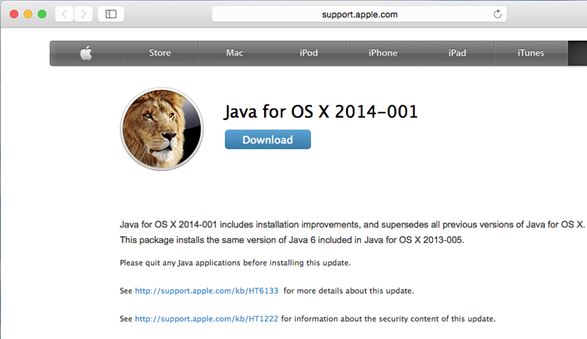

JAVA 6 FOR MAC OS INSTALL
The only recent apps which require you to install Apple’s old Java support are most of those in Adobe Creative Studio 6 and earlier, which will not run without it. By default, Safari and other browsers will not run Java automatically, but at least ask you if you want to enable it for that site, when it’s installed.Īpple used, a long time ago, to bundle Java with OS X, and still provides a separate installer if you need to support Java 6. Safari’s controls over Java are quite separate, and part of the Websites section of its Preferences. Java is normally installed as an add-in to macOS, and supports the running of Java apps via web pages and as standalone apps on your Mac. It has also been built into other apps as a scripting language: again, their support is built-in, and there are no separate components to install or keep updated. Unless you have good reasons to disable it, it is best enabled, as many websites stop working if your browser doesn’t handle its scripts. In Safari, you control JavaScript in the Security section of its Preferences dialog. Think of it as a type of AppleScript which runs in web pages. It’s most unfortunate that these two languages have such similar names, as it makes them so easy to confuse.Īlthough influenced by Java, JavaScript is an event-driven language used extensively on webpages, which is normally built into your browser and other apps which support it. Now you can easily build, run, and push containers from your Mac.Java and JavaScript are completely different To stop and clean up your workspace, run: AH00094: Command line: 'httpd -D FOREGROUND'įinally, you can create containers on your Mac and communicate with them. Trying to pull docker.io/library/httpd.Ĭopying blob 8ec398bc0356 25.8MiB / 25.8MiBĬopying config c2aa7e16ed 7.2KiB / 7.2KiB Now, let's run a container and communicate with it: 1 root vboxsf 480 Aug 28 05:40 container-proj You can log into the VM and view your shared directory at /sf_code:ĭrwxrwx. You now have a VM with a persistent disk for container images, but it runs the OS in memory. $ podman-machine create -virtualbox-boot2podman-url -virtualbox-memory="4096" -virtualbox-share-folder ~/Code:code fedbox In the meantime, I referenced the development release below: The image should make it to the official repo. I updated the image to Fedora 31 and allowed rootless image building. I am using a Fedora 31 virtual machine with 4GB of RAM, and I attached my local ~/Code directory to this VM. $ curl -L -output /usr/local/bin/podman-machine At the time of this writing, the latest release was v0.16: Start by downloading the latest podman-machine binary. The guide also assumes you have VirtualBox already installed. My instructions are based on the official ones here.
JAVA 6 FOR MAC OS DRIVER
You have the option of compiling additional driver support for hypervisors like xhyve, but I would recommend VirtualBox as it seems to work more smoothly. The developers released two VM flavors: an in-memory Tiny Core and a Fedora version. Podman-machine starts a virtual machine that already streamlines the Podman, Buildah, and skopeo packages. Look no further: Podman-machine has somewhat solved this problem. While it is simple enough to install Red Hat CodeReady Containers, what I really needed was a way to run Buildah, Podman, and skopeo on macOS without having to water and feed a Linux VM. My daily laptop is a MacBook Pro, which is great unless you want to dual boot into Linux and develop on containers.


 0 kommentar(er)
0 kommentar(er)
